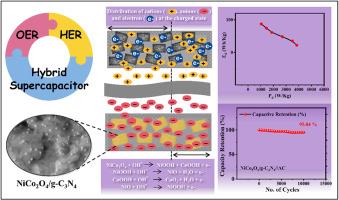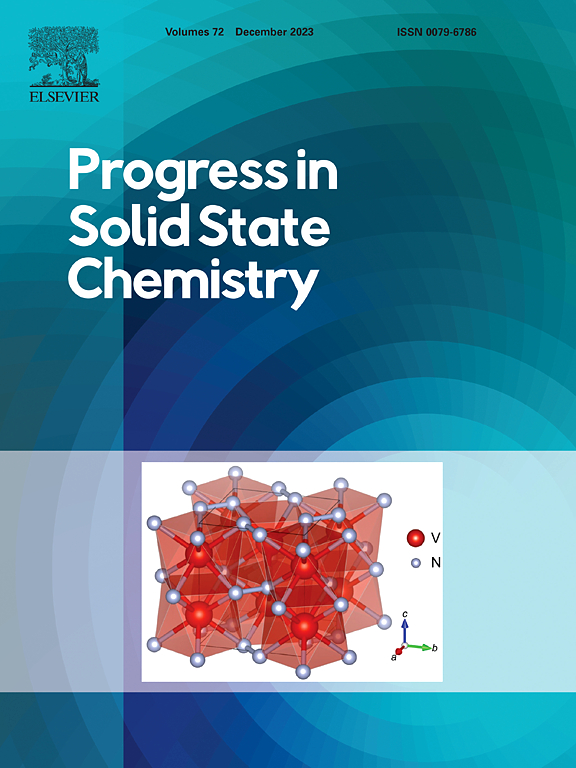集成了g-C3N4纳米结构的片状NiCo2O4用于混合超级电容器和绿色能源技术
IF 10.5
2区 化学
Q1 CHEMISTRY, INORGANIC & NUCLEAR
引用次数: 0
摘要
用于超级电容器和绿色能源应用的纳米结构电极材料的开发仍然是一项具有挑战性的任务,特别是在实现最佳电极-电解质相互作用的最大表面积方面。在本研究中,我们采用经济高效的水热法合成了互连的纳米结构NiCo2O4/g-C3N4。采用各种技术对NiCo2O4/g-C3N4纳米复合材料进行了结构、形态和电化学性能的综合表征。NiCo2O4/g- c3n4材料制备的电极具有203 C/g的高比容量(Qs)。此外,所制备的非对称超级电容器(ASC)在1.4 a /g下的能量密度(Ed)为87.3 Wh/kg,功率密度(Pd)为1038 W/kg,具有优异的循环性能,在10,000次循环后仍能保持95.04%的容量。此外,我们还对改性NiCo2O4/g-C3N4电极在析氧反应(OER)和析氢反应(HER)中的电催化性能进行了评价。结果表明,NiCo2O4/g-C3N4电极表现出最佳的OER性能(10 mA/cm2时过电位(η) = 287 mV, Tafel斜率= 121 mV/dec),并表现出优异的HER活性(- 10 mA/cm2时η = 336 mV, Tafel斜率= 93 mV/dec)和优异的循环稳定性。这项研究突出了NiCo2O4/g-C3N4作为超级电容器和绿色能源技术的有前途的材料的潜力。本文章由计算机程序翻译,如有差异,请以英文原文为准。

Plate-like NiCo2O4 integrated with g-C3N4 nanostructures for hybrid supercapacitors and green energy technologies
The development of nanostructured electrode materials for supercapacitors and green energy applications remains a challenging task, particularly in achieving maximum surface area for optimal electrode-electrolyte interaction. In this study, we synthesize interconnected nanostructured NiCo2O4/g-C3N4 using a cost-effective hydrothermal method. The NiCo2O4/g-C3N4 nanocomposite undergoes comprehensive characterization to analyze its structural, morphological, and electrochemical properties using various techniques. Electrodes fabricated from the NiCo2O4/g-C3N4 material exhibit a high specific capacity (Qs) of 203 C/g. Additionally, the as-fabricated asymmetric supercapacitor (ASC) achieves a remarkable energy density (Ed) of 87.3 Wh/kg and a power density (Pd) of 1038 W/kg at 1.4 A/g, with superior cycling performance, retaining 95.04 % of its capacity after 10,000 cycles. Furthermore, we evaluate the modified NiCo2O4/g-C3N4 electrodes for their electrocatalytic performance in the oxygen evolution reaction (OER), and hydrogen evolution reaction (HER). The results indicate that the NiCo2O4/g-C3N4 electrode exhibits the best OER performance (overpotential (η) = 287 mV and Tafel slope = 121 mV/dec at 10 mA/cm2) and demonstrates excellent HER activity (η = 336 mV and Tafel slope = 93 mV/dec at −10 mA/cm2) with exceptional cyclic stability. This research highlights the potential of NiCo2O4/g-C3N4 as a promising material for supercapacitor and green energy technology.
求助全文
通过发布文献求助,成功后即可免费获取论文全文。
去求助
来源期刊

Progress in Solid State Chemistry
化学-无机化学与核化学
CiteScore
14.10
自引率
3.30%
发文量
12
期刊介绍:
Progress in Solid State Chemistry offers critical reviews and specialized articles written by leading experts in the field, providing a comprehensive view of solid-state chemistry. It addresses the challenge of dispersed literature by offering up-to-date assessments of research progress and recent developments. Emphasis is placed on the relationship between physical properties and structural chemistry, particularly imperfections like vacancies and dislocations. The reviews published in Progress in Solid State Chemistry emphasize critical evaluation of the field, along with indications of current problems and future directions. Papers are not intended to be bibliographic in nature but rather to inform a broad range of readers in an inherently multidisciplinary field by providing expert treatises oriented both towards specialists in different areas of the solid state and towards nonspecialists. The authorship is international, and the subject matter will be of interest to chemists, materials scientists, physicists, metallurgists, crystallographers, ceramists, and engineers interested in the solid state.
 求助内容:
求助内容: 应助结果提醒方式:
应助结果提醒方式:


